UT reader Bryan Stewart sent us this great video, and wrote, “I was out on the 10th shooting video with my d7000 and 300mm lens of an ISS pass and got surprised by a Perseid meteor.”
Take a look!
UT reader Bryan Stewart sent us this great video, and wrote, “I was out on the 10th shooting video with my d7000 and 300mm lens of an ISS pass and got surprised by a Perseid meteor.”
Take a look!
[/caption]
A new opportunity is available for students and teachers to be part of history and fly the very first Student Spaceflight Experiments Program (SSEP) mission to the International Space Station. This program is open to students from any country that is part of the ISS partnership, in grades 5-12 as well as colleges and universities.
This opportunity offers real research done on orbit, with students designing and proposing the experiments to fly to the space station.
“Science is not something that can only be carried out by an elite community of researchers,” Dr. Jeff Goldstein, the Director for the National Center for Earth and Space Science Education told Universe Today. “It’s really just organized curiosity, and can be undertaken by anyone. So to inspire our next generation of scientists and engineers, we thought we’d give students an opportunity to do real scientific research on America’s newest National Laboratory – the International Space Station.”
SSEP is a program that launched in June 2010 by the National Center for Earth and Space Science Education in partnership with NanoRacks, LLC, a company that is working with NASA under a Space Act Agreement as part of the utilization of the International Space Station as a National Laboratory.
Two previous SSEP missions flew on the final shuttle flights, but this is the first to be part of the ISS science program.
NanoRacks hopes to stimulate space station research by providing a very low-cost 1 kilogram platform and other hardware that puts micro-gravity projects within the reach of universities and small companies, as well as elementary and secondary schools through SSEP. So, this is actually a commercial space program and not a NASA program.
On the previous SSEP missions with the space shuttles, 1,027 student team proposals were submitted with 27 experiments selected to fly, representing the 27 communities.
“We know even 5th graders can rise to this challenge and amaze us all,” Goldstein said, “and they already proved it on the final two flights of the Space Shuttle.”
The countries that can participate are the US, Canada, Japan and the European nations that are partners in the ISS program.
SSEP Mission 1 to ISS is now open for registration, with participating communities selected no later than September 30, 2012, so this is time critical.
Goldstein noted there are a significant number of resources that make this process straight-forward, including an instructionally designed recipe allowing teachers to easily facilitate the introduction of the program in the classroom, conduct experiment design, and do the proposal writing.
There are five categories of participation:
Pre-College (the core focus for SSEP) in the U.S., (grades 5-12), with a participating school district—even an individual school—providing stunning, real, on-orbit RESEARCH opportunities to their upper elementary, middle, and high school students
2-Year Community Colleges in the U.S., (grades 13-14), where the student body is typically from the local community, providing wonderful pathways for community-wide engagement
4-Year Colleges and Universities in the U.S., (grades 13-16), with an emphasis on Minority-Serving Institutions, where the program fosters interdisciplinary collaboration across schools and departments, and an opportunity for formal workforce development for science majors
Communities in the U.S. led by Informal Education or Out-of-School Organizations, (e.g., a museum or science center, a homeschool network, a boy scout troop), because high caliber STEM education programs must be accessible to organizations that promote effective learning beyond the traditional classroom
Communities in ISS Partner Nations: EU nations, Canada, and Japan with participation through NCESSE’s Arthur C. Clarke Institute for Space Education.
Goldstein said the program is a U.S. national Science, Technology, Engineering, and Mathematics (STEM) education initiative that gives up to 3,200 students across a community—middle and high school students (grades 5-12), and/or undergraduates the ability to fly their own experiments in low Earth orbit on the International Space Station.
For more information see the SSEP website
Read about the experience of previous SSEP program schools on the space shuttle
Watch a video of Dr. Jeff Goldstein talking about SSEP.
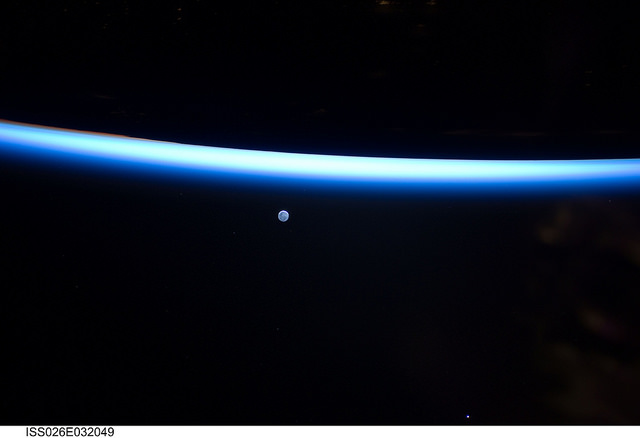
[/caption]
Ah, the Moon! Earth’s constant companion and the subject of songs, poetry, and many an astrophoto here on Universe Today. But we always gaze upon the Moon under the cover of Earth’s atmosphere. Does it look any different from up above the world so high? Astronauts from the ISS have taken plenty of pictures of the Moon, and here are a couple recent and notable lunar images. The one above is of a crescent Moon taken in March of this year (2011) — notice the bright crescent sliver present even while the entire moon is visible. Here, the Moon looks teeny tiny. Below is another view of a bigger, but still crescent Moon as seen from the ISS.
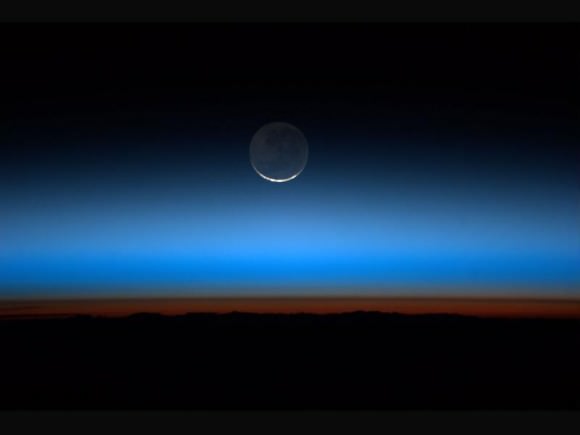
Expedition 28 astronaut Ron Garan took this image just a few days ago on July 31, 2011 from the International Space Station. This is such a stunning image, it was featured on NASA’s Image of the Day Gallery. Garan noted the view saying, “We had simultaneous sunsets and moonsets.” For anyone in orbit, this extraordinary event is a daily occurrence. Since the station orbits the Earth every 90 minutes, each day the crew experiences such a view about 16 times a day.
See more from Ron Garan on his Twitpic page.

[/caption]
Space Shuttle Atlantis closed out NASA’s Space Shuttle Era with a safe touchdown on July 21, 2011 at the Kennedy Space Center in Florida at the conclusion of the STS-135 mission, the 135th and final shuttle mission.
I was extremely fortunate to be an eyewitness to history and one of the lucky few journalists permitted by NASA to follow along as Atlantis took her historic final journey back from wheels stop at Runway 15 at the Shuttle Landing Facility as a flight worthy orbiter.
A convoy of 25 specialized vehicles safe each orbiter after landing. Some four hours later, Atlantis was towed off the runway with a diesel powered tractor for about 2 miles along the tow way leading to the Orbiter Processing Facility which lies adjacent to the Vehicle Assembly Building (VAB) at KSC.
The STS-135 crew consisted of Shuttle Commander Chris Ferguson, Pilot Doug Hurley and Mission Specialists Sandra Magnus and Rex Walheim.
Check out my Towback Photo Album below, and prior album from wheels stop at the shuttle runway earlier in the day, here:
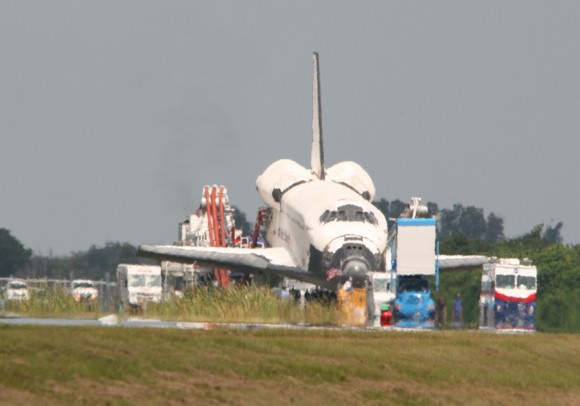
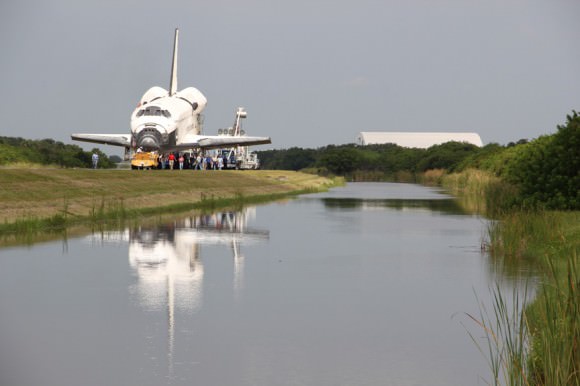
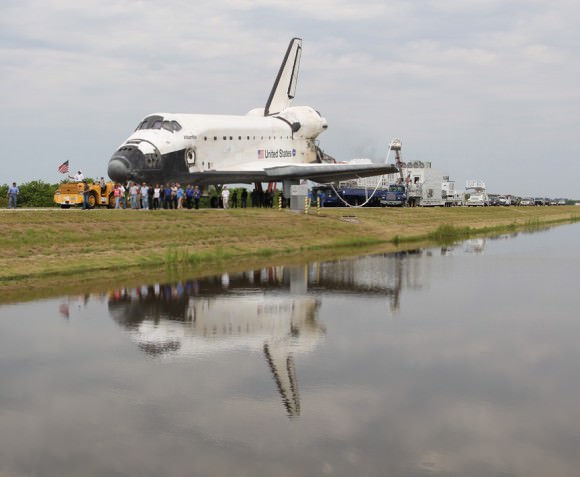

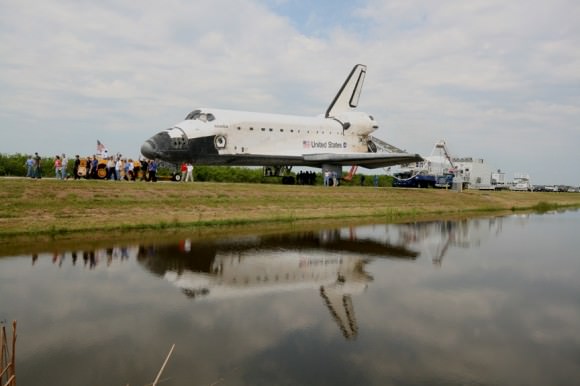
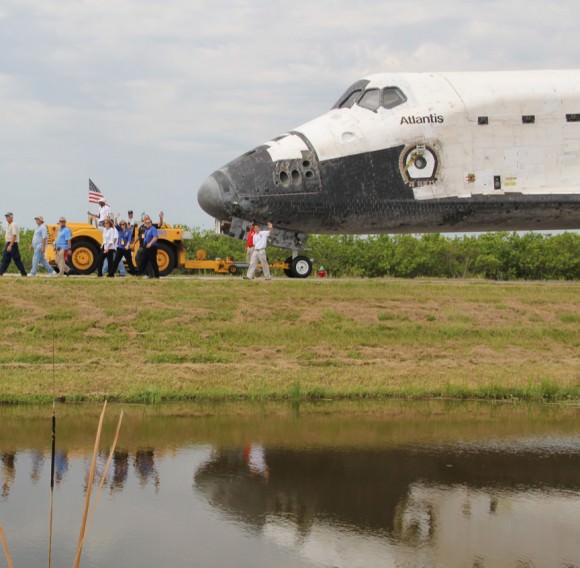
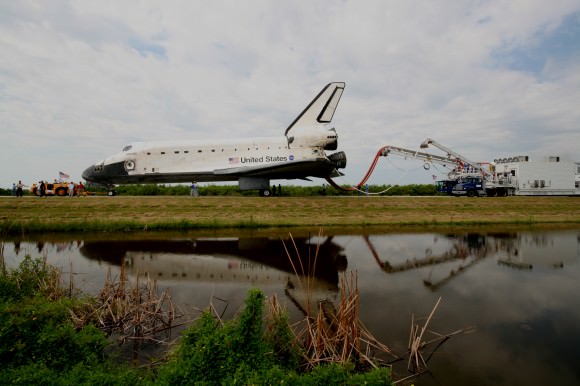
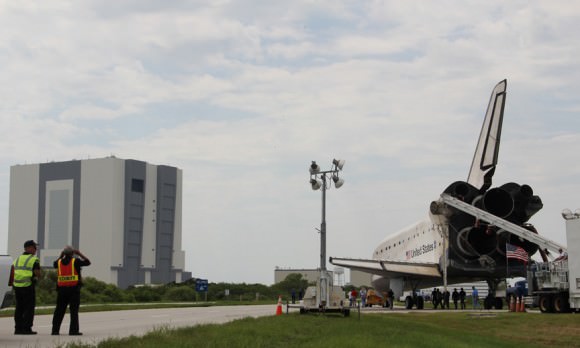
Read my features about the Final Shuttle mission, STS-135:
Wheels Stop ! With Awesome Atlantis on the Shuttle Runway – Photo Gallery Part 1
Ghostly Landing of Atlantis Closes America’s Space Shuttle Era Forever
Love of Science Drives Last Shuttle Commander – Chris Ferguson Brings Science Museum to Orbit
Revolutionary Robotic Refueling Experiment Opens New Research Avenues at Space Station
Water Cannon Salute trumpets recovery of Last Shuttle Solid Rocket Boosters – Photo Album
Shuttle Atlantis Soars to Space One Last time: Photo Album
Atlantis Unveiled for Historic Final Flight amidst Stormy Weather
Counting down to the Last Shuttle; Stormy weather projected
Atlantis Crew Jets to Florida on Independence Day for Final Shuttle Blastoff
NASA Sets July 8 for Mandatory Space Shuttle Grand Finale
Final Shuttle Voyagers Conduct Countdown Practice at Florida Launch Pad
Final Payload for Final Shuttle Flight Delivered to the Launch Pad
Last Ever Shuttle Journeys out to the Launch Pad; Photo Gallery
Atlantis Goes Vertical for the Last Time
Atlantis Rolls to Vehicle Assembly Building with Final Space Shuttle Crew for July 8 Blastoff
[/caption]
Taken by NASA astronaut and Expedition 27 flight engineer Ron Garan, this image shows the Petermann Ice Island (PII-A) currently adrift off the coast of Labrador. The island is a chunk of ice that broke off the Petermann Glacier in Greenland in August of 2010 and has been moving slowly southward ever since. It is currently about 21 square miles (55 square km) in size – nearly the same area as Manhattan!
Garan’s original photo was posted to his Twitter feed earlier today… I cropped the full-size version, rotated it so that south is down and edited it to bring out surface details in the island. Ridges in its surface can be seen as well as many bright blue meltwater ponds.

Overlaid on the left side is an approximate scale size of Manhattan. This thing is BIG!
PII-A is currently drifting toward Newfoundland but is unlikely to reach land… its base will run against the sea floor long before that. But it has been reported to be posing a problem for ships and offshore oil rigs. (Read more about PII-A on NASA’s Earth Observatory site here.)
When he’s not performing other duties aboard the Space Station, Ron Garan posts photos of Earth from orbit on his Twitter feed (@Astro_Ron) and also on his website FragileOasis.org, thereby sharing his unique and privileged perspective on our world. Founded by Garan, Fragile Oasis is a site that supports and publicizes many global projects supporting humanitarian and environmental missions. Visit, become a member, and you too can “learn, act, and make a difference.” After all, who better than an astronaut would know how much our world is connected, and how fragile it really is!
Image credit: NASA / Ron Garan. Edited by Jason Major.
PS: If you want an idea of how something like this would look like up close, check out this video below taken from a ship near one of the smaller pieces of the ice island!
_______________________
Jason Major is a graphic designer, photo enthusiast and space blogger. Visit his website Lights in the Dark and follow him on Twitter @JPMajor or on Facebook for the most up-to-date astronomy awesomeness!
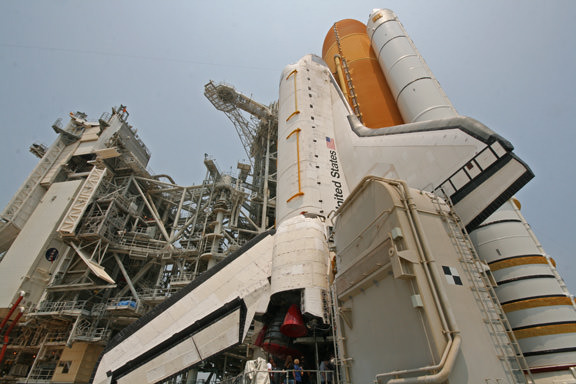
[/caption]
In the weeks leading up to the launch of Space Shuttle Atlantis, I had the distinct honor to speak on several occasions with Chris Ferguson, the Space Shuttle Commander of the STS-135 mission that will soon close out NASA’s Space Shuttle Era.
Chris talked to me about his childhood experiences that led him to “love science” and how he strongly believes in “giving back” to a community that enriched him so much – and eventually led him to his career as a space shuttle astronaut.
That passion for science and giving will result in an extraordinary and out of this world gift to the people of Philadelphia, Pennsylvania, hometown to Chris Ferguson that he hopes will inspire kids to love science.
I first met Chris about two years ago in Philadelphia when he generously gave a well received presentation to our astronomy club, the Rittenhouse Astronomical Society – which meets at the Franklin Institute Science Museum and where I frequently lecture too.
At that time Ferguson had already been a veteran space flyer with two trips to the International Space Station – but he not yet been named to command the last shuttle flight. Over 150 folks attended Ferguson’s talk – held in the presence of the marble statue of Benjamin Franklin. The statue is a US National Historic Landmark.
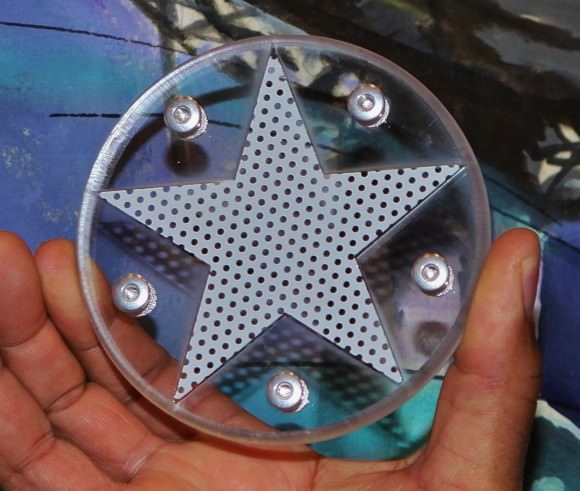
As a child, Chris attended classes from grade school to high school in Philadelphia, the city of brotherly love.
“I developed and cultivated a love of science, engineering and space in many childhood trips to the Franklin Institute in Philadelphia,” Ferguson told me.
“I was always a science oriented kid growing up. I have an innate curiosity for how things work. The Franklin Institute fed my curiosity.”
“And it was some teachers I had at a young age in my high school in Philadelphia who made me want to understand more. And to understand the reason about why things work the way they do … And to understand why the physical laws that govern the Universe are the way they are.”
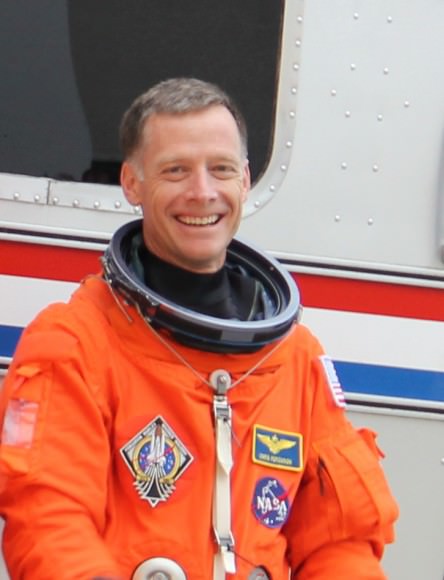
“The one thing I could never fathom well was understanding spaceflight. And the way to really understand something is to go do it,” said Chris Ferguson.
“What this is really about is going into space, living and working there and dragging the American public along with us. We need to constantly feed the machine for the folks who are curious and are on a quest to understand things they don’t understand and desire to wonder what’s beyond low Earth orbit and how you live in space for a long period of time.”
“The only way you feed that is by planting the seeds when they are young. You grow the big Oaks out of little acorns.”
“And you get the little acorns at places like the Franklin Institute and the Smithsonian National Air & Space Museum. That’s what did it for me,”
“I think you need to go back and you need to give back. So I’m looking forward to going back to the Franklin Institute !” said Ferguson
And when Chris does go back to the Franklin Institute later this year he will bring along a very very special gift – a piece of the Institute’s Fels Planetarium dome flew millions of miles to the space station and back aboard history’s very last Space Shuttle orbiter – Atlantis – that will ever take a star trek to the High Frontier.
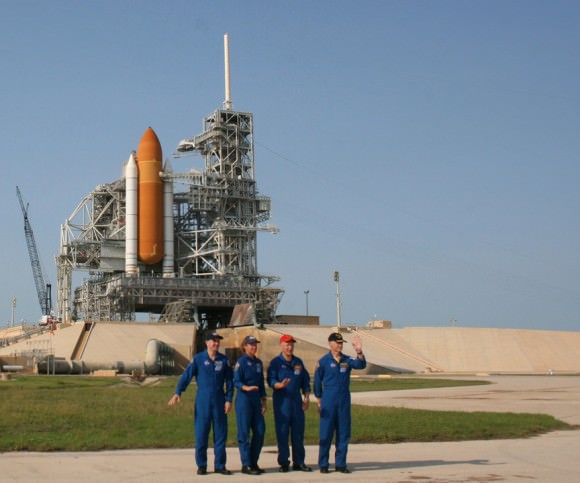
And the project was Ferguson’s idea according to Derrick Pitts, Chief Astronomer at the Fels Planetarium of the Franklin Institute.
“Chris sent me an email asking if we (The Franklin Institute) would like to fly something on STS-135,” Pitts told me.
“I quickly agreed, found out what the criteria for launch would be and then pulled a team together to figure out what to send. It was decided to send a star-shaped piece of the original Fels Planetarium dome.
“The original dome was replaced in 2002 but I’d kept several large sections of the stainless steel panels and had a number of 5-pointed stars about 4″ across cut from the panels to mount and give as gifts to friends of the Fels. It weighs about 6 oz.”
“Since more than 10 million visitors have sat under that dome including several school students who would later become NASA astronauts, it seemed fitting to send one of these stars.”
“The piece presented some problems though. As a stainless steel piece, it has sharp edges and 5 very sharp points – both verboten by NASA and it is ever so slightly oversized. We fixed the worst problem by encasing the star – points edges and all – in a transparent acrylic ‘jewel box’ sandwich held closed with stainless steel screws.”
“We had about ten days from the first email to delivery date to him in Houston. When it returns to Earth, Ferguson has offered to bring it back to Philadelphia where we’ll put it on permanent display in the main Planetarium hallway. This will be the second time Franklin has flown an article with a native Philadelphian astronaut. Our last trip was with Jim Bagian on STS-40 in 1991.”
Chris is a humble, eloquent and down to earth guy and knows how lucky he is to be commanding the grand finale of the thirty year long shuttle program. And he is determined that he and his STS-135 crew of four do their very best to accomplish all their goals.
“I’m just proud to be a small part of it and am savoring the moment. We’re focused on the mission now and will have time to ponder this moment in history when it’s all over,” Ferguson concluded.
Space Shuttle Atlantis and her crew of 4 are scheduled to land at 5:56 a.m. on July 21, 2011 at the Kennedy Space Center in Florida.
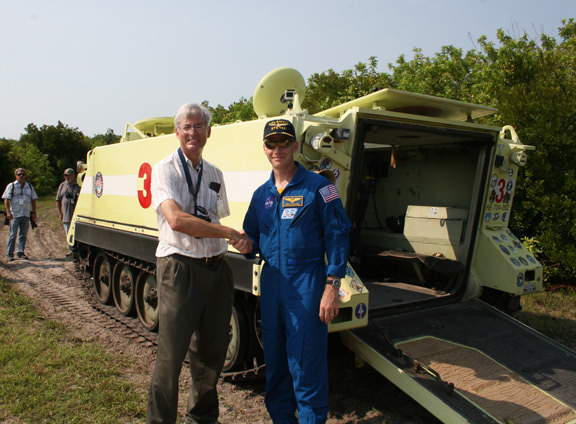
Read my features about the Final Shuttle mission, STS-135:
Revolutionary Robotic Refueling Experiment Opens New Research Avenues at Space Station
Water Cannon Salute trumpets recovery of Last Shuttle Solid Rocket Boosters – Photo Album
Shuttle Atlantis Soars to Space One Last time: Photo Album
Atlantis Unveiled for Historic Final Flight amidst Stormy Weather
Counting down to the Last Shuttle; Stormy weather projected
Atlantis Crew Jets to Florida on Independence Day for Final Shuttle Blastoff
NASA Sets July 8 for Mandatory Space Shuttle Grand Finale
Final Shuttle Voyagers Conduct Countdown Practice at Florida Launch Pad
Final Payload for Final Shuttle Flight Delivered to the Launch Pad
Last Ever Shuttle Journeys out to the Launch Pad; Photo Gallery
Atlantis Goes Vertical for the Last Time
Atlantis Rolls to Vehicle Assembly Building with Final Space Shuttle Crew for July 8 Blastoff</a
“Poetry in motion, as Atlantis conducts the last RBAR Pitch Maneuver in shuttle program history,” says NASA TV commentator Rob Navais. Piloted by Space Shuttle commander Chris Ferguson, Atlantis moves through this 9-minute, 360-degree rotation directly beneath the International Space Station. Commonly called the “Belly Flip,” only about 90 seconds of actual high-resolution photography is taken during the entire maneuver. It enables the ISS crew to photograph Atlantis’ Thermal Protection System for engineers on the ground to check for any damage to the heat resistant tiles.
[/caption]
The last Space Shuttle in history that will blast off for space was unveiled today at the Kennedy Space Center (KSC) in Florida amidst terrible weather. Heavy rain showers and thunderstorms are inundating the space center during prelaunch preparations for the blast off of Space Shuttle Atlantis.
Two lightning strikes occurred within about a third of a mile of Launch Pad 39 at 12:31 p.m. and 12:40 p.m. EDT. After engineering teams evaluated data from the strikes, NASA shuttle managers decided it was safe to proceed with launch preparations.
Following about a 40 minute delay, Atlantis was unveiled for liftoff after retraction of the massive rotating service structure which protects the orbiter from inclement weather and impacts from foreign object debris.
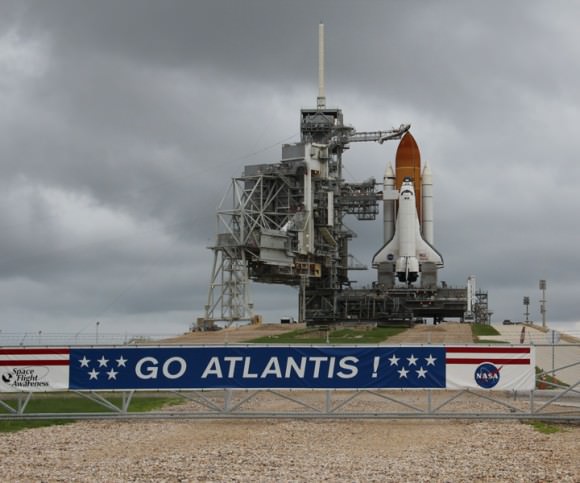
The chances of favorable weather for launch of the STS-135 mission on Friday July 8 are just 30%, meaning 70% NO GO said Shuttle Weather officer Kathy Winters at a briefing for reporters today at KSC. Liftoff is targeted for 11:26 a.m. EDT.
NASA has a narrow window of three opportunities on July 8, 9 and 10 and must then stand down for nearly a week because the US Air Force has scheduled a Delta rocket launch on July 14. If the Air Force would agree to delay the Delta by few days, NASA could launch Atlantis on Monday or Tuesday in case for further launch delays.
Upwards of 750,000 spectators are expected.
Atlantis goal is deliver the Raffaello logistics module and the Robotic Refueling Mission to the ISS on a 12 day mission that will end the shuttle era.
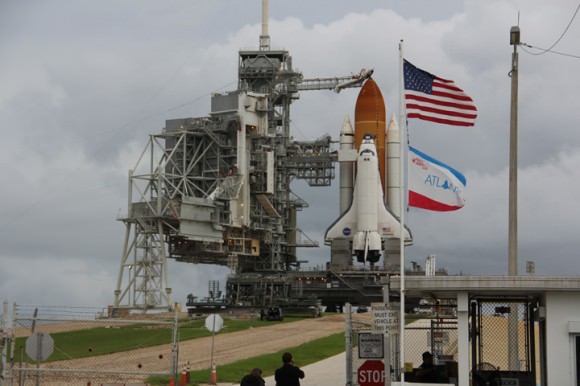
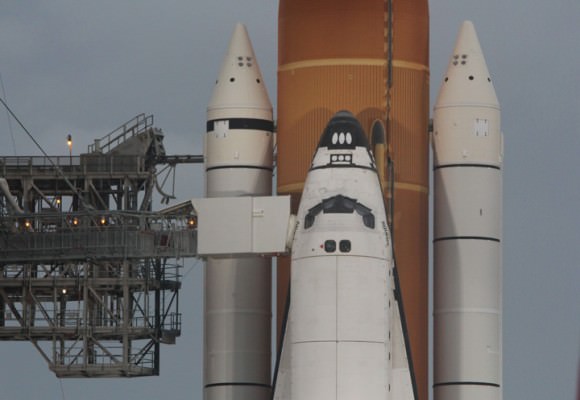
Video of Lightning Strike near Shuttle Launch Pad
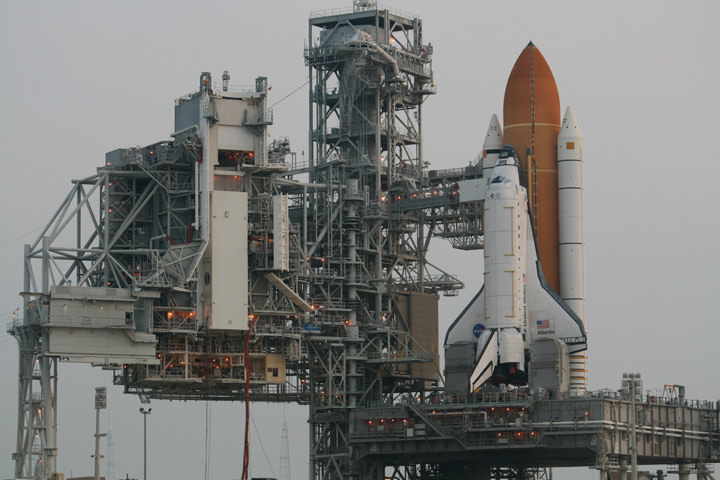
[/caption]
The countdown to NASA’s 135th and final shuttle launch began today (July 5) with no technical issues blocking liftoff at this time. But upwards of 750,000 spectators may be disappointed because the weather on launch day, July 8, is looking decidedly dicey. Storm weather and stormy seas lie ahead for NASA.
At today’s press briefing, Shuttle Weather Officer Kathy Winters projected that the chance of favorable weather is only 40% for Friday’s 11.26 a.m. liftoff of Atlantis because of the likely threat of rain at the Kennedy Space Center.
The 12 day STS-135 mission will loft about 9500 pounds of supplies and equipment that NASA shuttle managers state are absolutely “mandatory” in order to keep the International Space Station operating at full capacity for the next year.
“I wish I had a better weather briefing for you, but it does look like we are going to have some weather, at least potential for weather, in the area at launch time,” said Winters. “Right now, we’re going with a 60 percent chance of KSC weather prohibiting launch due to the potential for showers and isolated thunderstorms in the area.”
In the event of a one day delay to Saturday, the chances for favorable weather increases considerably to 60%. For a two day delay to July 10, the chances of acceptable weather climbs to 70%.
After July 10, the liftoff of the STS-135 mission would have to be delayed to July 16 because NASA would be forced to stand down shuttle launch operations in order to allow the Air Force to launch a military navigation satellite on July 14 from Cape Canaveral. That is unless the Air Force relents – out of consideration for the three quarters of a million folks expected to jam the Florida space coast beaches, highways and hotels – and offers NASA the opportunity to launch Atlantis for several days starting on July 11 – in case of a launch delay.
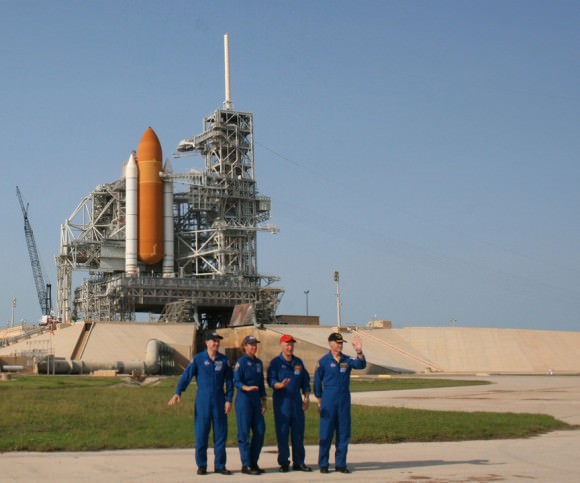
Space fans need to be patient and plan for undesired contingencies just like NASA by packing extra provisions like food, water and clothing and also should consider extended accommodations.
Clocks began ticking backwards today at 1p.m.EDT at the T Minus 43 hour mark towards the final blastoff of Space Shuttle Atlantis.
NASA Test Director Jeremy Graeber said at today’s briefing that Atlantis is ready to fly.
“Our teams here at the Kennedy Space Center and all the NASA centers across the country have been working for over a year to prepare Atlantis, the external tank our solid rocket boosters, the payload and all of our ground systems for the STS-135 mission,” Graeber stated. “All of our vehicle and ground systems are ready, the STS-135 crew, Atlantis and the launch team are all ready to proceed and we’re looking forward to a spectacular launch on Friday morning.”
STS-135 payload manager Joe Delai said the payloads and the Raffaello cargo carrier module are ready to go as well. “The primary objective of Atlantis is to resupply the ISS for one year. About 9500 pounds are going up. This is the largest payload in terms of volume.”
Delai said that Raffaello was specially modified to increase its cargo carrying capacity by several hundred pounds.
The STS-135 mission will bring NASA’s 30 year long shuttle program to a definite close and simultaneously mark the termination of the US capability to launch humans to space for at least several years.
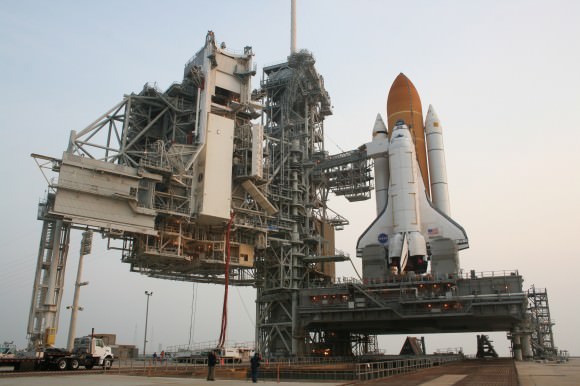
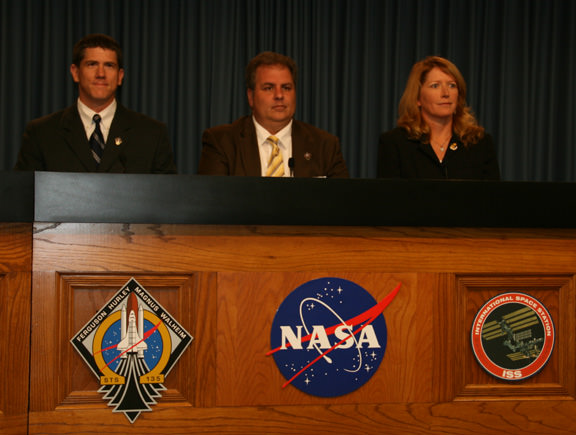
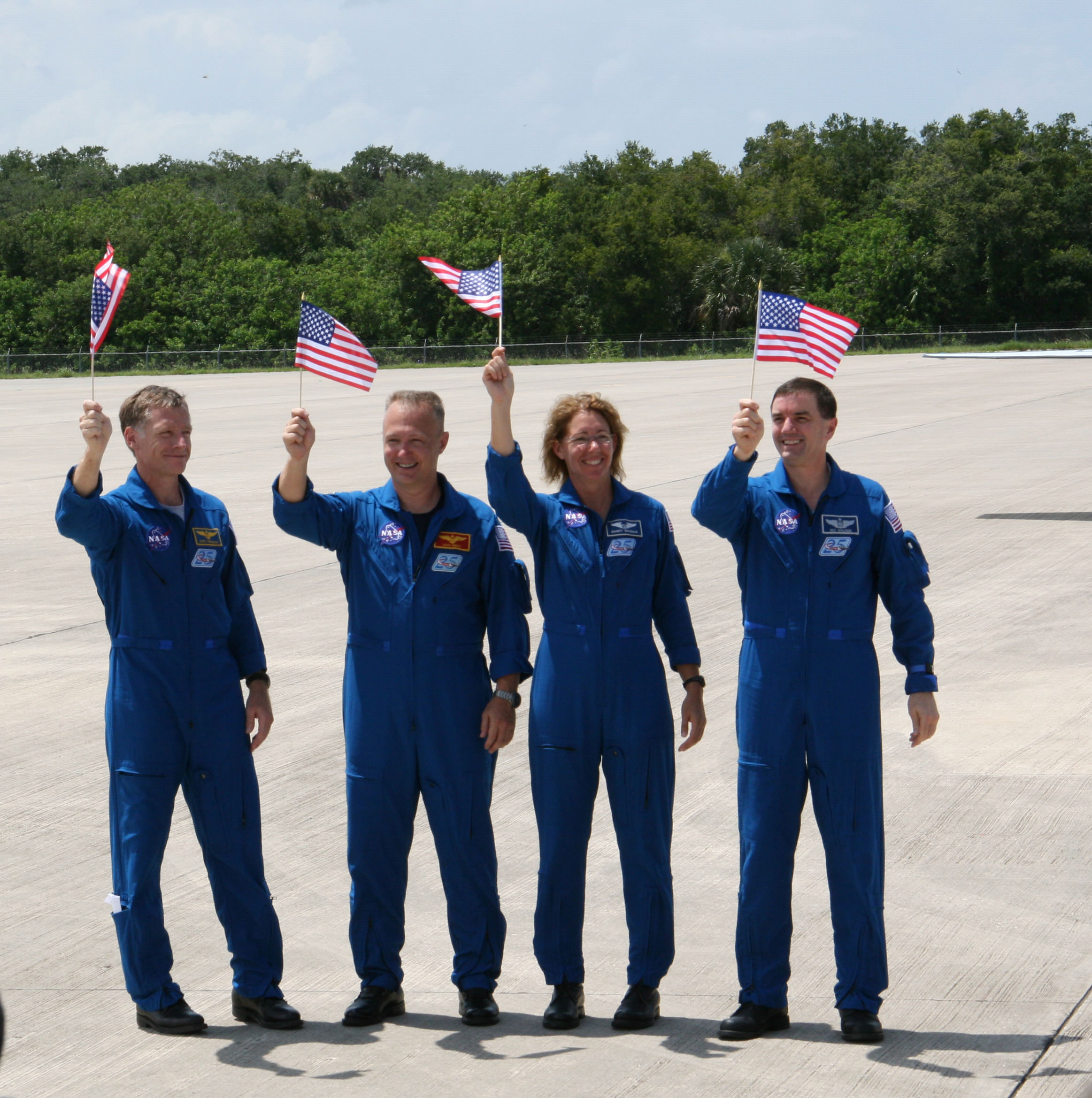
[/caption]
The four astronauts who will fly the Grand Finale of NASA’s space shuttle program arrived at the Florida launch site on Independence Day on a wave of T-38 training jets. The veteran crew flew into the Kennedy Space Center (KSC) from Ellington Field in Houston, Texas and touched down at the shuttle landing strip at about 2:30 p.m. EDT.
Blast off of Space Shuttle Atlantis on the STS-135 mission is slated for July 8 at 11.26 a.m. with Shuttle Commander Chris Ferguson at the helm. He is joined by Pilot Doug Hurley and Mission Specialists Sandy Magnus and Rex Walheim.
Upon landing in the sweltering Florida heat, the astronauts were welcomed by Space Shuttle Launch Director Mike Leinbach as well as other NASA/KSC officials and a large crowd of media. Many waved US flags in honor of the July 4th Independence Day holiday.
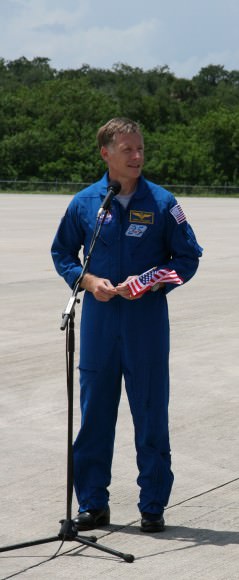
“I think I speak for the whole crew in that we are delighted to be here after a very arduous nine month training flow and we’re thrilled to finally be here in Florida for launch week,” said Ferguson. “This is a day that’s decidedly American, a day where we kind of reflect on our independence and all the wonderful things that we really have as part of being the United States of America. I think it’s wonderful you’ve all come out to join us.”
“We have a very event-filled mission ahead of us, we have 12 days, we’ll be very, very busy,” Ferguson added. “When it’s all over, we’ll be very proud to put the right-hand bookend on the space shuttle program.”
The quartet will spend the next few days completing final prelaunch training to prepare for their planned 12 day flight bound for the International Space Station.
The primary cargo is the Raffaello Multipurpose Logistics module built in Italy and jam packed with some five tons of spare parts, science gear, food, water, clothing and more that will be transferred to the station by the station and shuttle crews and are absolutely essential to keep the orbiting outpost operating over the next year.
About 2000 journalists and photographers are expected to cover Atlantis’s launch, the largest media gathering for a shuttle launch since the Return to Flight in 2005 – that’s about twice the media here for the last launch of Endeavour in April.
The countdown clock begins ticking at 1 p.m. EDT on Tuesday, July 5
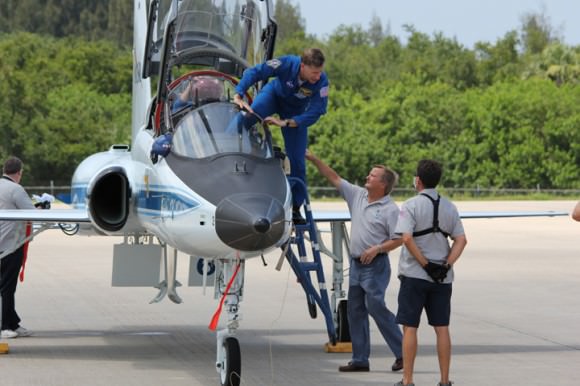
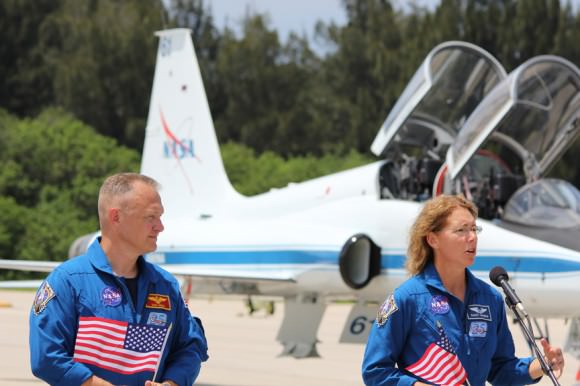
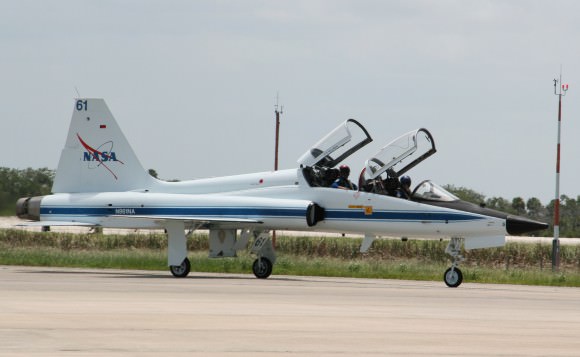
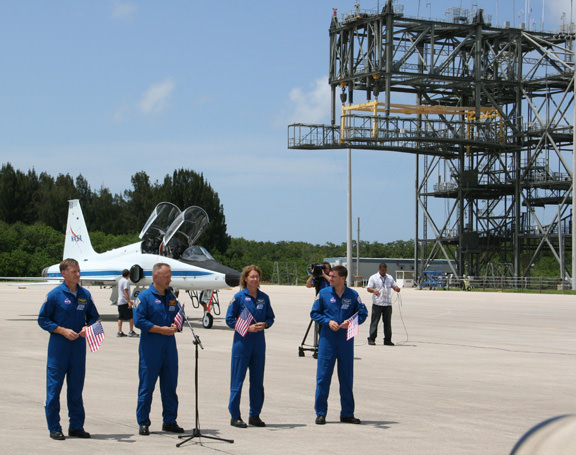
Read my prior features about the Final Shuttle mission, STS-135, here:
NASA Sets July 8 for Mandatory Space Shuttle Grand Finale
Final Shuttle Voyagers Conduct Countdown Practice at Florida Launch Pad
Final Payload for Final Shuttle Flight Delivered to the Launch Pad
Last Ever Shuttle Journeys out to the Launch Pad; Photo Gallery
Atlantis Goes Vertical for the Last Time
Atlantis Rolls to Vehicle Assembly Building with Final Space Shuttle Crew for July 8 Blastoff